Obsolete Currency
After the end of the American Revolutionary War, the U.S. government struck coinage, but did not issue any official paper currency for circulation. This made everyday commerce difficult, as large transactions would be very cumbersome if completed solely with coins. Accordingly, private banks and institutions began to issue banknotes to ease commerce.
These notes are referred to as "Obsolete Currency" because they ceased circulating during the Civil War. Between 1810 and 1865, countless banks, railroads, states, canal companies and private merchants issued currency in many different denominations. Some are very colorful and all are historic: odd denominations include 2 cent, $1.50, $3, $4, etc.
During the Civil War, the various Confederate States issued their own banknotes to circulate alongside Confederate currency. Obsolete currency is some of the most attractive and historically interesting currency produced in this nation. Add some to your collection!
- Found 23 items
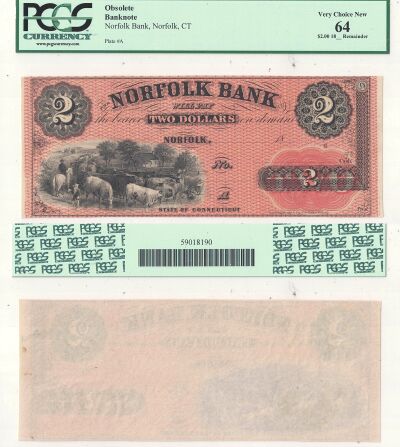 Undated. $2. PCGS. Very Ch-64. CT.$409.00
Undated. $2. PCGS. Very Ch-64. CT.$409.00Remainder. Norfolk Bank. A wonderful fully framed note that exhibits strong red and black inks and original paper. A vignette on the left portrays cattle being driven. Attractive and eye appealing.
Item #250972 (1 / 23)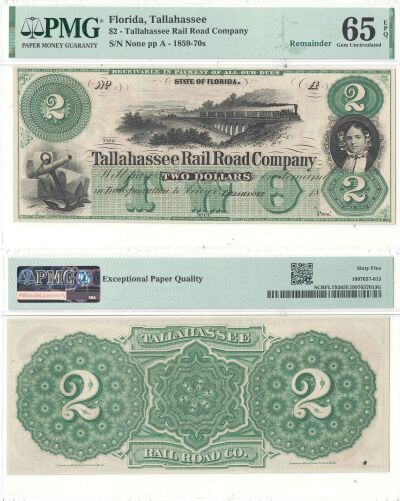 Undated. $2. PMG. Gem-65. EPQ. FL.$525.00
Undated. $2. PMG. Gem-65. EPQ. FL.$525.00Remainder. Tallahassee Rail Road Company. Vivid green and black inks blend with premium paper. Vignettes include a panoramic train scene, an anchor, and a woman with a bonnet.
Item #250859 (2 / 23)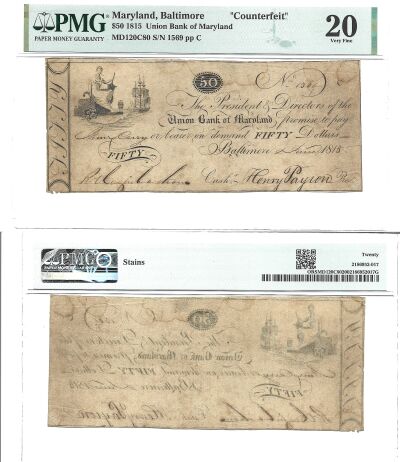 1815. $50. PMG. VF-20. MD.$525.00
1815. $50. PMG. VF-20. MD.$525.00Union Bank of Maryland. Counterfeit. Comment: Stains. A contemporary counterfeit of a rare early Baltimore obsolete. Stains in the upper right are not significant and blend in well.
Item #248321 (3 / 23)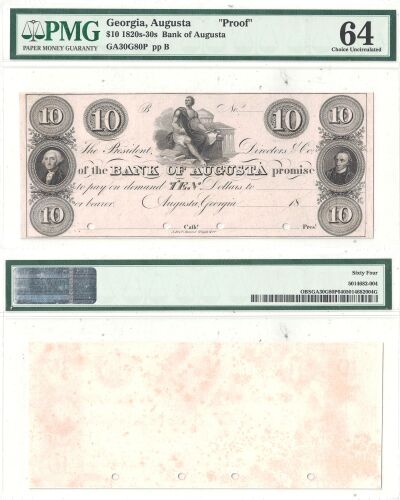 1820's-30's. $10. PMG. Ch Unc-64. GA.$350.00
1820's-30's. $10. PMG. Ch Unc-64. GA.$350.00Proof. Bank of Augusta. Listed in Haxby only as a regular issue for the design. A portrait of George Washington can be seen on the left and a seldom used portrait of Patrick Henry can be seen on the right. Typical PC's can be found along the signature lines. Very attractive.
Item #241208 (4 / 23) 1830's. $20. PCGS. Very Ch-64. MD.$119.00
1830's. $20. PCGS. Very Ch-64. MD.$119.00Susquehanna Bank. Port Deposit. MD-280-G12. Shank 102.11.8. Maid seated with spool of yarn.
Item #216740 (5 / 23)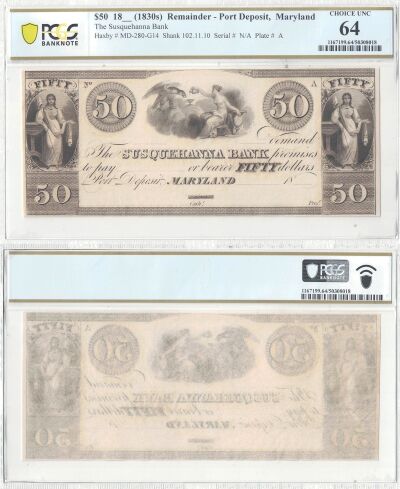 1830's. $50. PCGS. Very Ch-64. MD.$139.00
1830's. $50. PCGS. Very Ch-64. MD.$139.00Susquehanna Bank. Port Deposit. MD-280-G14. Shank 102.11.10. Maid pouring water for eagle.
Item #251404 (6 / 23)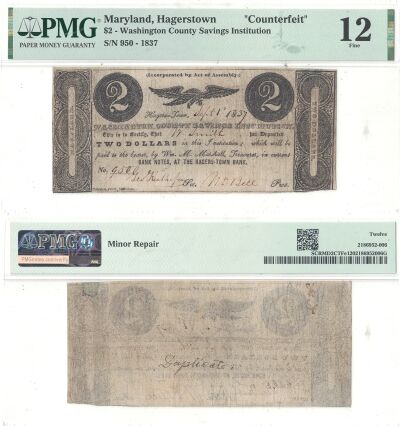 1837. $2. PMG. F-12. MD.$450.00
1837. $2. PMG. F-12. MD.$450.00Hagerstown. Washington County Savings Institution. Counterfeit. Comment: Minor Repair. Light repair near the upper right corner is minor.
Item #248459 (7 / 23)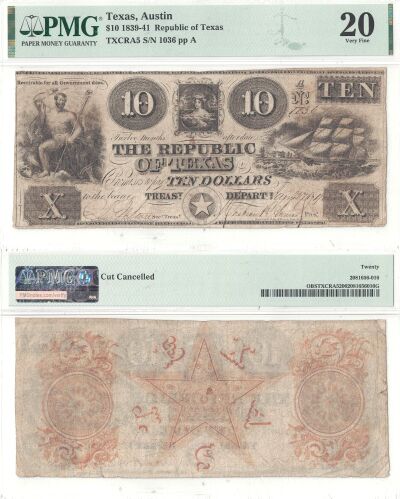 1839-41. $10. PMG. VF-20. TX.$599.00
1839-41. $10. PMG. VF-20. TX.$599.00Cut Cancelled. Republic of Texas. An attractive example with strong color and solid paper. A typical cut cancel can be easily overlooked.
Item #244715 (8 / 23)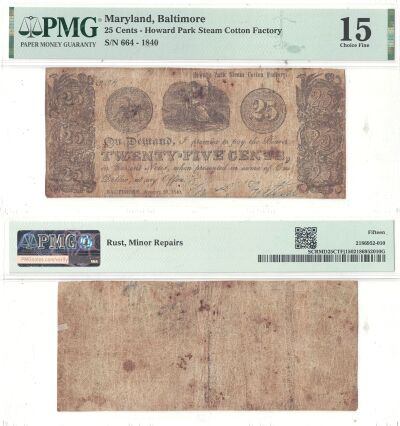 1840. 25c. PMG. Ch F-15. MD.$395.00
1840. 25c. PMG. Ch F-15. MD.$395.00Baltimore. Howard Park Steam Cotton Factory. Comment: Rust Minor Repairs. R-6. Vignettes include a Bust 25c reverse design. Rust spots sprinkle into even wear. Repairs are of little distraction.
Item #248429 (9 / 23)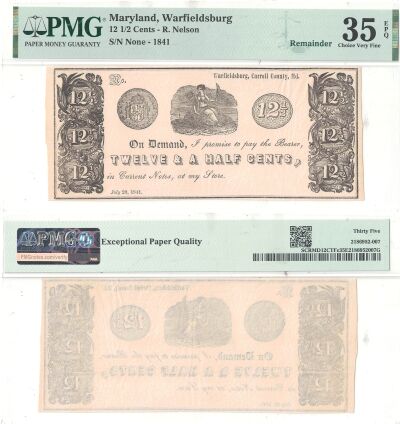 1841. 12 1/2c. PMG. Ch VF-35. EPQ. MD.$475.00
1841. 12 1/2c. PMG. Ch VF-35. EPQ. MD.$475.00Warfieldsburg. Carroll County. R. Nelson. Remainder, R-7. R. Nelson was the owner of a general store and the local agent for Stainburn's Vegetable Extract Anti-Bilious Pills. Well centered with only light folding and premium paper.
Item #248425 (10 / 23)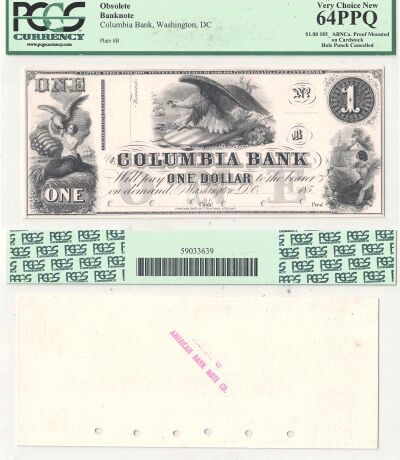 185_. $1. PCGS. Very Ch-64. PPQ. DC.$469.00
185_. $1. PCGS. Very Ch-64. PPQ. DC.$469.00Columbia Bank. Washington, DC. Mounted on Cardstock. Hole Punch Cancelled. From one of the many fraudulent banks in business in DC from 1852-56. Vignettes include Hebe offering a drink to an eagle, an eagle perched on a federal shield, and Ceres kneeling in a field. The appearance is bright and fresh. Typical POC's lie across the signature lines.
Item #248411 (11 / 23) 1850-60's. $5. PMG. VF-25. FL.$329.00
1850-60's. $5. PMG. VF-25. FL.$329.00Bank of St. Johns. A cotton plant is the central vignette. Attractive red and black ink with solid paper.
Item #249746 (12 / 23)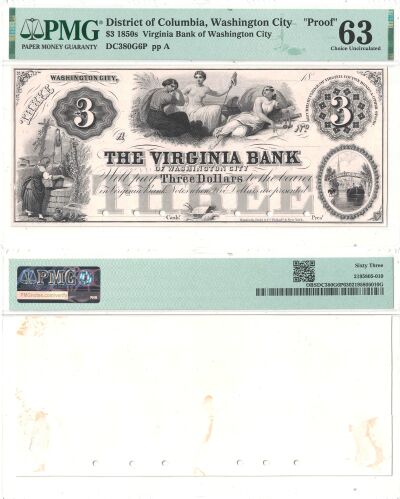 1850's. $3. PMG. Ch Unc-63. DC.$525.00
1850's. $3. PMG. Ch Unc-63. DC.$525.00Virginia Bank Of Washington City. Proof. Vignettes include: Agriculture, Freedom, and Science gathering together; collecting well water; and a canal boat. Printed on India paper and mounted on cardstock, 6 typical POC's lay across the signature lines.
Item #251093 (13 / 23)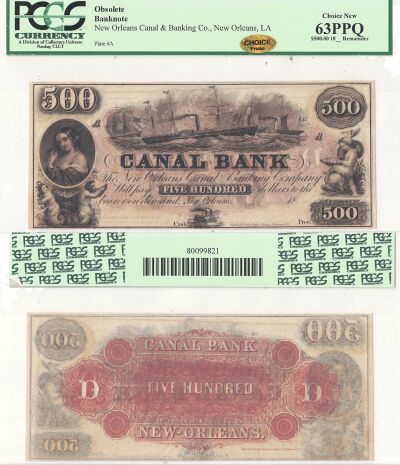 1850's. $500. PCGS. Ch New-63. PPQ. LA.$425.00
1850's. $500. PCGS. Ch New-63. PPQ. LA.$425.00Canal Bank. New Orleans. Remainder. Vignettes include a paddlewheel steam frigate surrounded by sailing ships and a young girl on the left. Attractive and well centered with premium paper.
Item #251148 (14 / 23)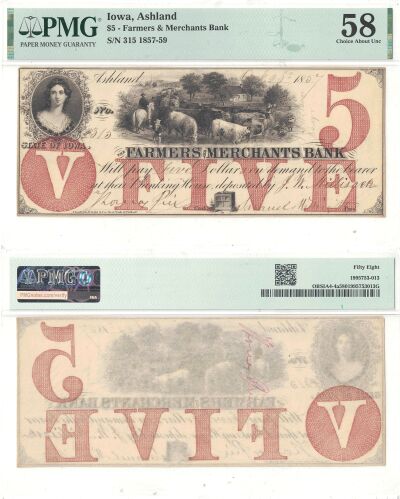 1857-59. $5. PMG. Ch AU-58. IA.$550.00
1857-59. $5. PMG. Ch AU-58. IA.$550.00Farmers and Merchants Bank. Ashland. A lovely note with black ink and large red protectors. A central vignette features a cattle drive. Quite eye appealing!
Item #248228 (15 / 23)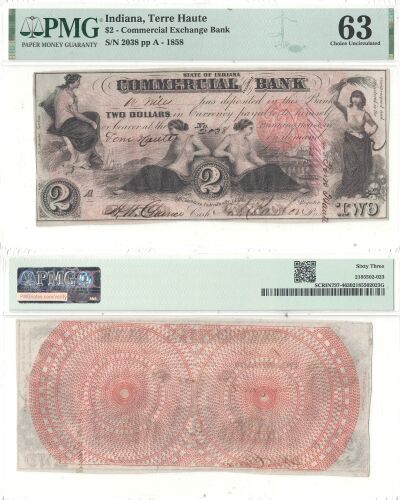 1858. $2. PMG. Ch Unc-63. IN.$295.00
1858. $2. PMG. Ch Unc-63. IN.$295.00Commercial Exchange Bank. A lovely issue that exhibits attractive vignettes and premium paper. Black ink and an orange seal rest upon the front and full orange color captures the back.
Item #251070 (16 / 23)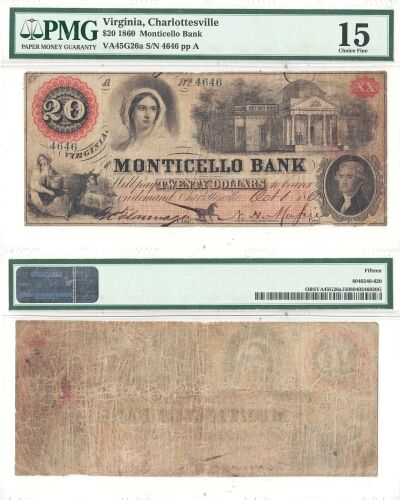 1860. $20. PMG. Ch F-15. VA.$289.00
1860. $20. PMG. Ch F-15. VA.$289.00Charlottesville. Monticello Bank. An attractive red and black ink note that exhibits pleasing vignettes and even wear. An unnoted pin hole blends in well.
Item #248841 (17 / 23) 1860's. $10. PMG. Gem-65. EPQ. LA.$1,059.00
1860's. $10. PMG. Gem-65. EPQ. LA.$1,059.00Remainder. Citizens Bank Of Louisiana, New Orleans. Vignette of the U.S.S. Adriatic at Sea. The famous "Dix" note. Perhaps the most beautiful obsolete note ever printed. This well centered example displays strong color and premium paper.
Item #240719 (18 / 23)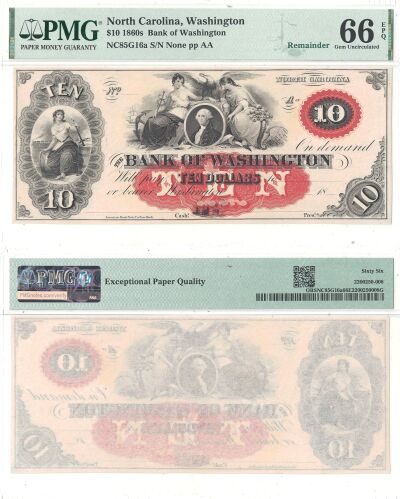 1860's. $10. PMG. Gem-66. EPQ. NC.$549.00
1860's. $10. PMG. Gem-66. EPQ. NC.$549.00Remainder. Bank of Washington, North Carolina. A bright crispy note with strong red and black ink. Vignettes include a central portrait of George Washington.
Item #250220 (19 / 23) 1861. $5. PMG. Ch AU-58. DC.$859.00
1861. $5. PMG. Ch AU-58. DC.$859.00Bullion Bank. Washington, DC. Lovely red and black inks provide excellent eye appeal. Much tougher than the lower denominations.
Item #250247 (20 / 23) Show more items...
Show more items...
- 23 items found














